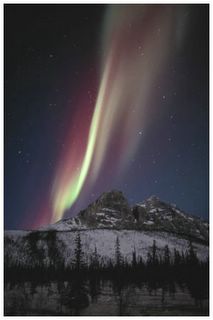
Photographing the Northern Lights
Photographing the Northern Lights or the Aurora Borealis can be a challenging endeavor. First and foremost, you must get to the right location. Some of the best sites in the world are Alaska, Finland or the northern portion of Canada. March and September are the premier months to photograph the Lights. For this shot, I flew into Fairbanks and traveled north eight hours into the Brooks Range. What I like about this location is that because it is above the Arctic Circle it increases your chances of seeing the Northern Lights. The weather in February and early March is often very clear and you are reasonably assured of clear nights. My accommodations were at a truck stop north of Fairbanks just inside the Brooks Range that offers food and lodging. I've found certain techniques will render the best results. First, a wide-angle lens increases the chances of incorporating the full sweep of these magnificent displays. Another benefit of using a wide-angle lens is to include some sort of landmass, such as the mountains in this example. I would recommend photographing the Northern Lights when there is a half moon out. The half moon provides enough illumination on the snow-clad mountains to bring out detail in the land and in the Lights. Fuji Provia 400 is an excellent film for this type of shot. It's fast enough and has a full range of color similar to the finer grain films. A 30-second exposure is long enough to capture the Northern Lights and yet short enough so the motion of the Lights is not washed out. If you use a longer exposure of one minute or more, often the lines within the Northern Lights move, producing a shot that is diffused and less striking. The fastest shutter speed that you can get away with produces the most interesting display. With Provia 400 you can be confident that at a 30-second exposure you're getting more than enough light for a proper exposure of the display. It's essential to use a cable release and a tripod. I set the camera's focus on infinity at the widest aperture, which was f2.8 for the lens I used. If you were to use an f1.4 or f1.0 lens, then you could use a faster shutter speed. On some lenses you have to be careful where you focus. If you go slightly beyond your lens' infinity point, as I have, you may be putting your subject out of focus. If you can use auto focus you'll find that's easier than trying to focus in the dark on a dark subject. When I came back from my trip to the north I was a little disappointed because I thought I had no color in the sky. To my naked eye the display appeared as a very pale green, almost white, display. After I got my film processed I was delighted to find beautiful reds and purples in the photo. This tells me that the color of the display is often deceiving and that the spectrum of red is not very evident to the naked eye in the darkness of the evening but it can be recorded on film. I photographed the Northern Lights at approximately 1:00 am and, fortunately, it was only about 10 degrees below zero with no wind. This is quite comfortable in the dry cold of the north. It could easily have been 50 degrees below zero, which presents all sorts of issues. Keeping yourself warm and your equipment functioning is a challenge. It's best to keep your camera reasonably cold, perhaps in the trunk of your vehicle, so there isn't a large temperature variation from warm to cold which will cause condensation to form on the lens.

0 Comments:
Post a Comment
<< Home